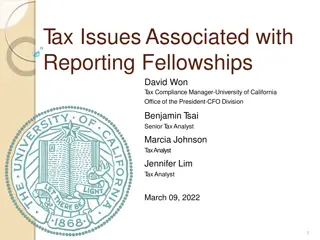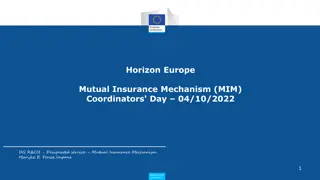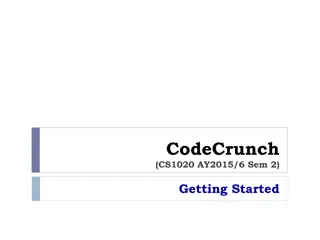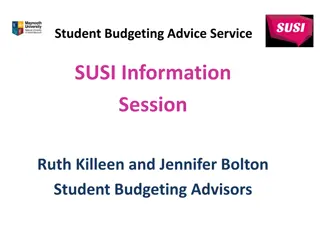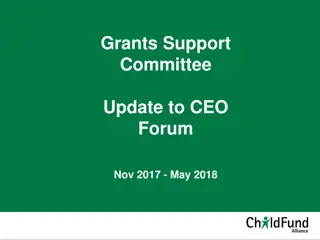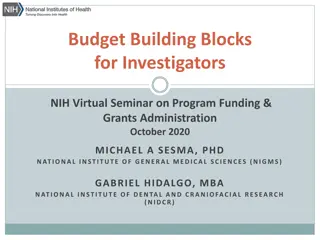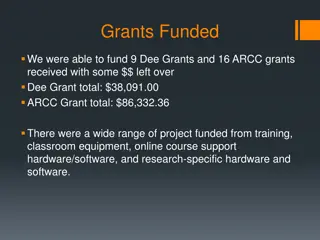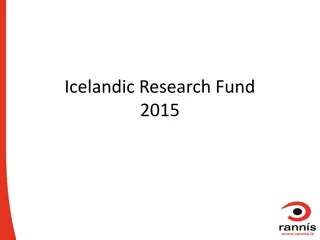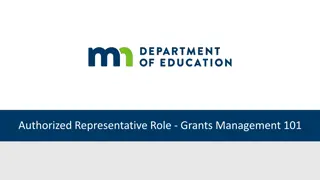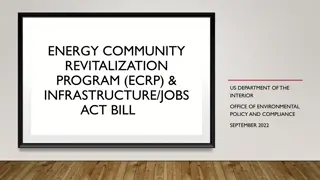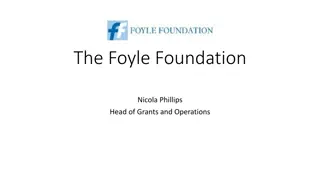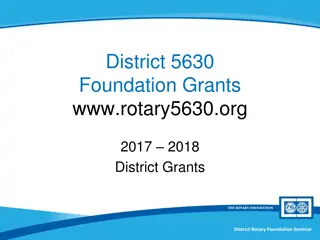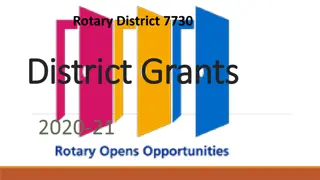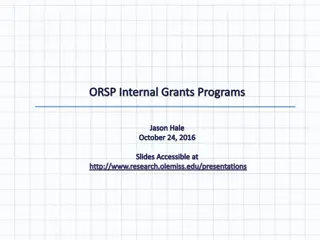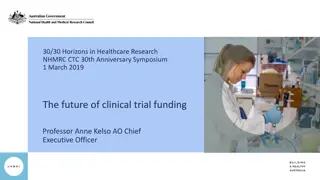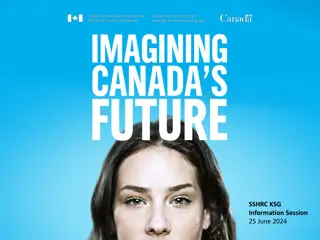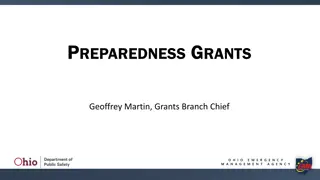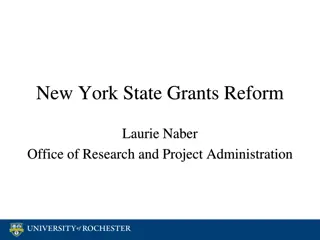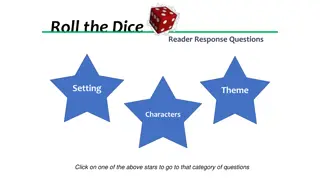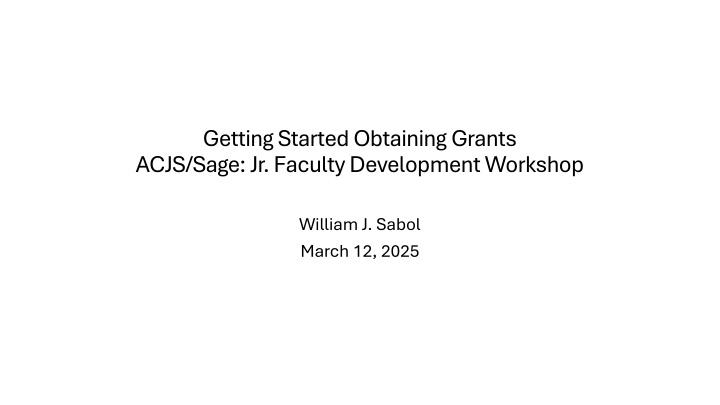
Insights on Obtaining Grants for Research Development
Learn about obtaining grants for research development, including tips for success, understanding funding mechanisms, navigating periods of uncertainty, and the benefits of securing research grants. Discover how to compete successfully in grant writing and explore the various types of funding mechanisms available.
Download Presentation

Please find below an Image/Link to download the presentation.
The content on the website is provided AS IS for your information and personal use only. It may not be sold, licensed, or shared on other websites without obtaining consent from the author. If you encounter any issues during the download, it is possible that the publisher has removed the file from their server.
You are allowed to download the files provided on this website for personal or commercial use, subject to the condition that they are used lawfully. All files are the property of their respective owners.
The content on the website is provided AS IS for your information and personal use only. It may not be sold, licensed, or shared on other websites without obtaining consent from the author.
E N D
Presentation Transcript
Getting Started Obtaining Grants ACJS/Sage: Jr. Faculty Development Workshop William J. Sabol March 12, 2025
What do I know about getting grants? Received 35 grants from various organizations as PI, co-PI, senior advisory More than $4.5 MN since coming to GSU in 2017 Made final funding decisions for BJS & NIJ Served as proposal reviewer for federal agencies and foundations, e.g.NIJ, BJS, NIH, CDC, RSF, Casey, others.
Getting grants during a period of uncertainty Federal government: Holds on grants; elimination of some grant programs. State & local governments: Uncertainty in some areas that depend on federal funding. Private foundations: Many have shifted to programmatic grants away from research, but several continue with research. Business and industry: Have specific interests that may be related to specific types of crime, e.g., cybersecurity, disorder crimes (location issues), and general climate. BE PREPARED!
Grants vs. other research funding mechanisms Grants: Most flexibility or the PI; discretion in direction and dissemination; funder wants notification prior to publishing. Common for some federal agencies (e.g., NJ) and foundations. Cooperative agreements: Government cooperates in / has a role in shaping the effort; government review varies; sometimes approval required before disseminating. Used by some federal agencies for different reasons, e.g., BJS build infrastructure; BJA policy reasons. Contracts: Extension of the funding entity; act like staff of the funder; funder reviews and approves and often issues publications. Used by some federal agencies more than others, e.g., HHS vs NIJ. Common among state & local governments and businesses. Interagency Agreements (IAA): Rare for research but possible for specific activities that support an agency s mission. Recipient must be a state or local government, e.g., a state university.
What does getting research grants take? Grant writing is very competitive! Competitors include: Senior faculty, Private research organizations Consortia of research entities. Grant writing requires a good idea! Grant writing takes time! Grant writing requires persistence! Grant writing involves careful attention to details! You must be able to accept rejection without getting dejected and try again. You must be able to accept rejection without getting dejected and try again.
Why get research grants? Permits you to conduct and develop your research agenda. Can pay your salary and keep you employed. Buyouts. Summer support. Allows you to hire help, purchase supplies or equipment. Can fund travel to scientific and professional meetings. Can work with others through cooperative agreements or subcontracts. Can work either as the one who initiates the subcontract or the one that receives them. Can pay for a workshop or conference. Can help you get ahead; research support is rewarded in the academy.
Where do you go to find out about research grants? Federal funding - www.grants.gov Catalog of Federal Domestic Assistance http://12.46.245.173/cfda/cfda.html Foundation Center private foundations http://foundationcenter.org/ Specific agencies and organizations: Federal and State agencies: NIJ, BJA, BJS, NIH/CDC, State Departments, Foundations: RSF, AV, Gates, WT Grant, Sloane local foundations (APF, Blank, Cleveland/Gund, ) Science Philanthropy Alliance, Associations: Chambers of Commerce, United Way, ,,, Businesses: Generally, requires building personal relationships or developing connections with entities; CoreCivic, LexisNexis, Delta, Note: Journals and publishers generally require disclosure statements about sources of funding. Some view research funded by certain entities or under certain conditions as suspect. Statements of independence and type of pre-publication review by funders helps overcome this.
How funders approach requests for proposals Feds (e.g., NIJ, BJS): Use RFP, NOFO (Notice of Funding Opportunity). Generally state limits on awards either in terms of maximum amounts or total amount available and expected number of awards. One shot per RFP. May resubmit or revise and resubmit. Foundations: Use concept paper followed by invitation to submit a full proposal. Screen applicants via the concept paper; if invited to submit, chances of wining increase. May work with applicant on revisions. Corporations: Generally, by invitation after negotiation.
Funders identify their priorities RSF: https://www.russellsage.org/research/categories/requests- proposals Areas: Behavioral Science and Decision Making in Context; Future of Work; Immigration and Immigrant Integration; Race, Ethnicity and Immigration; Social, Political, and Economic Inequality; Promoting Educational Attainment and Economic Mobility among Racially, Ethnically, and Economically Diverse Groups after the 2023 Supreme Court Decision to Ban Race-Conscious Admissions at Colleges and Universities. Constraints: RSF rarely considers projects for which the investigators have not already fully-developed the research design, the sample framework, access to data, etc. Investigators are encouraged to submit an LOI after they have developed and pre-tested survey instruments, completed preliminary data analyses if the data are publically-available or conducted some preliminary interviews for qualitative studies. WT Grant: https://wtgrantfoundation.org/funding
Funders identify their priorities WT Grant: https://wtgrantfoundation.org/funding Our current programs support high-quality research studies in our focus areas, career-development awards for promising early-career faculty, grants that encourage research institutions to make structural changes that encourage engaged research, and programs of good- neighbor grants that support nonprofit youth service providers in New York City. Current opportunities https://wtgrantfoundation.org/funding#current-opportunities
Core components of a successful grant proposal Idea: What you propose. Process: How you will address the idea. Program: How well your idea aligns with the funder s interests.
Idea & Program, Processes Idea & Program Does it align with the funder s goals and objectives? What types of projects does the sponsor support? Will the research add to knowledge, and will it make a difference? How will you demonstrate these? (Methodology, task/timeline, management.) Your dissertation may not be fundable, however good it is or was. Process: Meet all proposal deadlines and complete all forms. Know the sponsor s timelines and methods. Don t wait: DOJ uses Grants.gov and JustGrants.gov. Get help from your office of sponsored projects but know their deadlines and timeframes. You are ultimately responsible for a submission.
Elements of a proposal (from NIJ; like those of other agencies) BMR: Page limits, font size, spacing, deadlines. Title page* Table of contents Main body - Statement of the problem - Project design & implementation - Potential impact - Capabilities & competencies Appendices Plan for collecting performance measures Budget - LOE and base salaries plus multiyear adjustments - Benefits - Subcontracts (e.g., data collection, survey) - Consultants - Participant incentives - Other direct costs (e.g., travel, equipment, etc.) - Indirect (F&A) Budget narrative Additional components, e.g., CVs, letters of support, bibliography, tools/instruments, human subject protections, privacy certificate, request to use incentives/stipends; data management (archiving) plan, disclosures (OSP). *Contents of title page: Title, submission date, opportunity number, PI (and co-PI), author identifier (ORCID) , new investigator, keywords, contact information.
Building your case Proposals reviewed and evaluated on the significance of the problem and the methodology proposed to address it. Search the literature to find information and statistics to show the scope and intensity of the problem. Accurately summarize the literature to make your case and set up your problem. Reviewers know the research literature; you can t fool them. Reviews must be brief but compelling. (New faculty, PhD students focus too much time showing what they know or read and not enough time on methodology and plans.) Make a compelling case on both counts. Don t ignore the management plan. Look at review criteria and weight given to each section.
Consider review criteria in developing proposals NIJ Problem statement (15%) Responsiveness to the RFP / NOFO goals and objectives. Demonstrated understanding of the problem(s). Exhibited comprehension of the population and region of study. Illustrative awareness of the state of current research. Presenting a valid theoretical framework to justify the study and direct research questions and design. Documented importance of research questions or hypotheses and project goals and objectives. NIJ Project design & implementation (50% (Next slide) Common characteristic of drafts of proposals among new faculty, post-docs, PhD candidates: Too much focus on the literature review and not enough on the design, methods, and analysis. Too much effort showing knowledge rather than saying what is planned. Consider NIJ s weights for reviewing proposals: It places much more emphasis on the design and implementation than the literature review.
NIJs review criteria for project design & implementation Thoroughness and completeness of the discussion of the study s research design (e.g., type[s] of research methods to be employed, research setting, sampling methods, research protocols, operationalization and measurement, data collection processes and techniques, data strategy, and analysis plan, power analysis). Soundness of methods and analytic and technical approaches to address the proposed project s stated aim(s), answer research questions, or test hypotheses. Awareness and responsiveness to human subjects privacy, protection, and confidentiality issues. Attentiveness of potential pitfalls of proposed project design and feasibility of proposed actions to minimize and mitigate them. Feasibility of the proposed project as designed.
Proposal elementProblem statement This is the hook . You should be able to state this in one or two sentences at the very outset of the proposal. Don t write a mystery novel; be upfront; say what the issue is. Be clear, concise, and well-supported. Do not simply restate the general problem or issue identified in an RFP. Focus on the specific problem you want to address, e.g., an RFP on reentry: I plan to measure and estimate the impact of participating in XX program on post-prison employment. I will estimate the dosage of program participation by ZZ, and I will estimate the time to employment, number of jobs, days worked, and wages over a minimum of a three-year follow-up period.
Problem statement Connect your specific problem to the broader issues. Demonstrate its relevance using statistics and research findings. Say what makes you unique or special to study this problem. Demonstrate your knowledge of the issue. Go outside of criminology journals to learn about how other disciplines have studied the issue.
Project statement State clear and specific aims, objectives, research questions and hypotheses. Aims: Main goals of the research, e.g., study recidivism differences between groups. Objectives: Indicate in more detail the specific research issues addressed in the project, e.g., determine whether the types and amounts of services influence recidivism outcomes. Research questions: State clear and answerable questions that imply hypotheses.
Proposal elementProject design & implementation Study design: What design is best for your research? Experimental Observational Descriptive Cohort study Case-control study Cross-sectional study Panel study Describe the study population or sample, how they will be selected, and the methods to be used to analyze the data (e.g., statistical or qualitative methods).
Project design & implementation Data to be collected Experimental: How randomization will occur and why that choice. Observational: If new data are to be collected, say how, e.g., prospective or retrospective; methods to collect the data (e.g., conduct a survey, obtain agency data, use archived (secondary) data, get digital data from the Web, others. Measurement, methods and instruments Identify the key variables of your study and describe how you will measure them; connect measures to data sources used. Identify and describe any instruments to be used and report on their reliability. Define the outcome measures (dependent variables) and how they will be measured.
Project design & implementation Interventions: If your study evaluates an intervention, describe the treatment, the dosage, timing, method of administration, and how it will be received. Discuss all the necessary safeguards associated with delivering the treatment. Analysis plan: Describe your plan for analyzing the data. If you are doing statistical modeling describe your model in general form. Discuss left-hand and right-hand side variables. Provide the rationale for the analytic approach. Timeline: Prepare and provide a timeline for all project activities and be able to connect it to the staffing for the project.
Proposal elementCapabilities & competencies / Potential impact Capabilities & competencies: Qualifications, expertise, and experience of all staff Management plan and institutional support Letters of support/agreement Capacity to translate research findings into practice. Potential impact: Impact on the accumulation of knowledge: What will you learn, why it is important. Impacts on policy: What policy/practice solutions are implied by the research. Translation into action: Possibilities that the findings will impact the field.
Proposal elementBudget and budget narrative Comprehensive breakdown and justification of all costs. Follow the funders formats; these vary. E.g., NIH caps salary; OJP has specific caps; foundations limit indirect. Core budget elements: Level of effort and base salary: You must identify how much time you plan to spend on the project and justify that. Universities: Generally budget by percent of effort for 9-month salary and for summer support. The persons for which you receive a buyout or summer support may not correspond with the period(s) on which you will work on the project. E.g., GSU uses 12.5% for a full course buyout, but LOE is generally continuous. Research organizations: Generally budget by expected hours to be spent on the project.
Proposal elementBudget and budget narrative (cont.) LOE and base salary: Provide for each person. Check with your office of sponsored projects about how to present the budget. Check with your department char about the semester(s) when you expect to buyout courses. Some universities direct charge grant managers; if so, include an accurate level of effort for them. Benefits: Cover items like the organization s contribution to health care, retirement, and maybe sick leave, vacation, and paid holidays. Staff vs. Faculty: Vacation, sick leave, holidays apply differently. Check to see if the organization charges a specific code for sick leave, vacation or holidays or charges the salary line. If the latter, budget accordingly.
Proposal elementBudget and budget narrative (cont.) Consultants and subcontracts: You should get a budget and budget narrative for each of these, even if the funder does not request specific details for these. You will need it in your budget narrative (justification). Participant participation (incentives: Often used to compensate persons who are interviewed or survey respondents. Going rate for personal interviews is about $50. Other direct costs: Generally, travel, equipment, supplies. Travel: For data collection, meetings, conferences. Equipment: Must be directly used for the research, e.g., computers, software. Supplies: Printing, publication costs, mailing, advertising With restrictions on indirect (NIH), this category may be expanded to cover costs such as computer systems, accounting, grants management, which
Proposal elementBudget and budget narrative (cont.) Indirect costs (F&A, G&A): Federally-negotiated rates. Charge on all direct costs (except consultants/subcontracts) that account for the business operations of an organization, e.g., Labs., Computer systems that serve everyone, Accounting and grant management, Rent and utility, Organization officers (e.g., VPs) Universities may use these to support PhD students and post-docs. Know your entity s indirect split and be prepared to negotiate with your department chair for your fair share. Budget narrative: Document that justifies each cost element. You can get help on the budget from your office of sponsored projects BUT you are responsible for ensuring that all budget elements are accurate.
Proposal elementAbstract and title Write these last. Why? Need to know what you plan to do. Make titles clear, precise, accurate, and professional. E.g., A study of the effects of participating in intensive, in-prison employment training programs on post-prison employment. Avoid glib or cute titles and titles with jargon, e.g., don t say The secret life of offenders . Maintain an appropriate tone, e.g., don t say Our super awesome study of X . Don t trivialize, e.g., A study of Z, the magic bullet for recidivism Abstract: Convey what you intend to study, why it is important, how you will study it, and what you plan to do with the results. This sets the tone for reviewers by telling them what to expect. It may excite or turn-off reviewers. Needs to cover all of the main points of the proposal but needs to be clear and concise (e.g., 150-250 words).
Proposal review Be prepared for rejection but don t get dejected. An excellent hit rate is one-in-three. It s a competitive environment. Funders use different forms of peer review, scoring, and decision making. Feds may consider factors other than merit, such as geography, target populations, new investigator. Number of reviewers will vary among funders. Funder program officers organize and summarize reviewer comments and make recommendations to the funder s decision maker. Decision makers may override program officer recommendations. If not funded, you will receive reviewer comments. Use these to revise and improve your work.
Getting a grant Now you must do the work within the prescribed time frames and budget. Good luck. If you are the PI, be prepared to answer lots of questions and make lots of decisions. Keep in mind that decisions made early on in a project will impact your findings. Think about implications. Use one grant to think about developing your research agenda. Go for another grant! The 2nd and 3rd are easier than the first.

